Table of Contents
Introduction: Isabella Grape – Nature’s Nutraceutical Gem
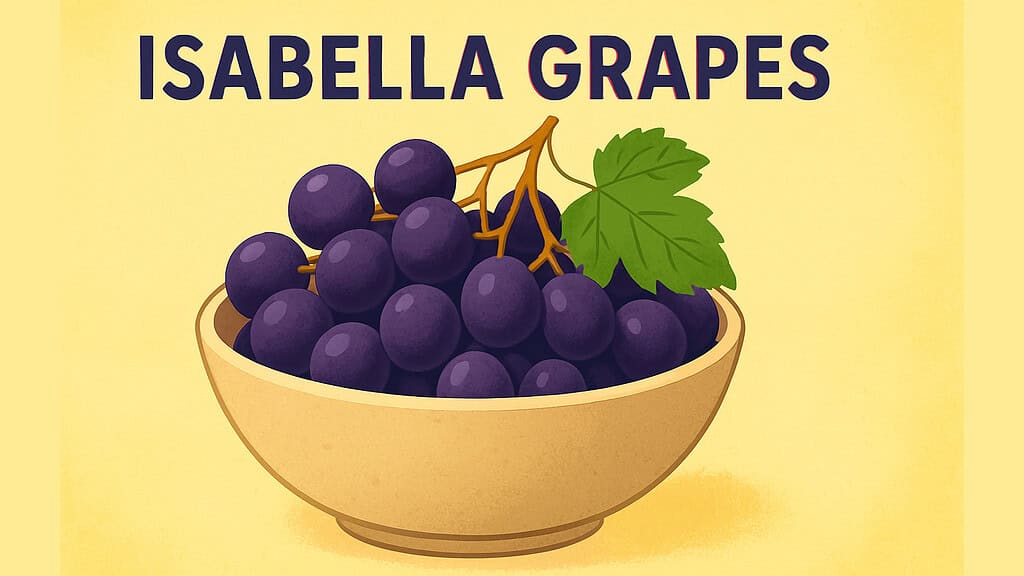
The Isabella grape belongs to the esteemed Vitaceae family and is recognized as a notable hybrid variety that has garnered scientific interest due to its outstanding health benefits. This unique cultivar, botanically classified as Vitis labrusca, traces its origins to eastern North America and represents one of nature’s most compelling examples of a functional food source. What sets this grape apart from conventional varieties lies in its distinctive aromatic profile and extraordinary concentration of bioactive compounds. The grape’s characteristic “slip-skin” feature and robust phenolic content make it a standout member of the fox grape family, which has given rise to numerous popular cultivars, including Catawba, Concord, and Delaware varieties.
Recent scientific investigations have illuminated the Isabella grape’s potential as a nutraceutical powerhouse, revealing complex molecular mechanisms through which its bioactive compounds interact with human physiology. The grape’s unique phytochemical signature includes substantial levels of resveratrol, anthocyanins, and various flavonoids that work synergistically to promote human health across multiple biological systems.
The growing body of research surrounding Isabella grape consumption points toward its significant role in preventive health strategies. Studies have demonstrated measurable impacts on cardiovascular function, oxidative stress management, and inflammatory response modulation, establishing this variety as more than just a flavorful fruit.
Table 1: Comparative Analysis of Isabella Grapes with Other Grape Varieties
| Variety | Scientific Name | Origin | Key Compounds | Skin Characteristics | Primary Uses |
|---|---|---|---|---|---|
| Isabella | Vitis labrusca “Isabella” | North America | High resveratrol, anthocyanins | Slip-skin, thick | Wine, juice, nutraceuticals |
| Muscadine | Vitis rotundifolia | Southeastern US | Ellagic acid, quercetin | Thick, tough | Wine, fresh eating |
| Fox Grape | Vitis labrusca | Eastern N. America | Flavonoids, tannins | Slip-skin | Wild foraging, hybrids |
| Scuppernong | Vitis rotundifolia | Southeast US | Resveratrol, ellagitannins | Bronze, thick | Wine, preserves |
| Catawba | Vitis labrusca “Catawba” | Ohio Valley | Anthocyanins, tartaric acid | Medium thickness | Wine, juice |
| Concord | Vitis labrusca “Concord” | Massachusetts | High anthocyanins | Blue-black, slip-skin | Juice, jelly, wine |
This comprehensive exploration will examine eight distinct health benefits associated with Isabella grape consumption, each supported by current scientific research and established biochemical principles. The evidence reveals how this remarkable fruit variety contributes to human wellness through multiple pathways, offering insights into its potential role in modern preventive medicine and nutritional therapy.
1. Isabella Grape and Cardiovascular Wellness
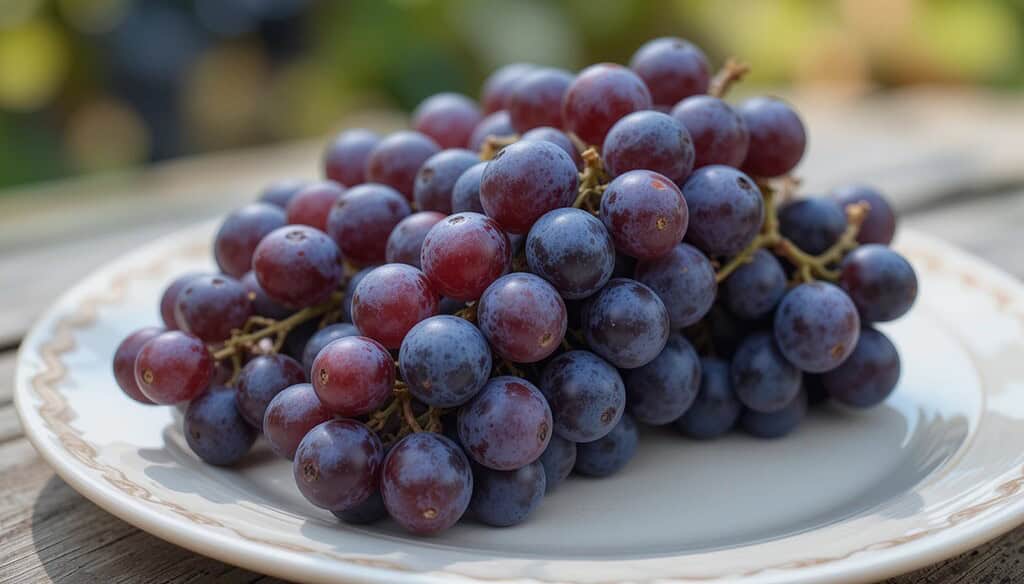
The cardiovascular benefits of Isabella grape consumption represent one of the most extensively documented aspects of its health-promoting properties. Research has consistently demonstrated that the polyphenolic compounds found in these grapes, particularly resveratrol and flavonoids, exert profound protective effects on the cardiovascular system through multiple mechanisms.
Clinical studies have shown that grape supplements containing resveratrol improved inflammatory and atherogenic status in subjects at risk for cardiovascular disease, as well as in patients with established coronary heart disease. This finding underscores the therapeutic potential of Isabella grape compounds in both primary and secondary cardiovascular disease prevention.
The vascular benefits of Isabella grape consumption extend beyond simple antioxidant activity. The bioactive compounds present in these grapes influence endothelial function by promoting nitric oxide production, which leads to improved vasodilation and reduced arterial stiffness. This mechanism contributes to better blood pressure regulation and enhanced circulation throughout the body.
Epidemiological studies examining populations with regular grape consumption have revealed notable correlations between intake patterns and cardiovascular health outcomes. The French Paradox phenomenon, while primarily associated with red wine consumption, highlights the protective effects of grape-derived polyphenols against coronary heart disease, even in populations with higher saturated fat intake.
Research on Vitis labrusca grape juices demonstrated that acute consumption promoted significant decreases in lipid peroxide levels in serum and thiobarbituric acid reactive substances in plasma. This reduction in oxidative markers indicates improved cardiovascular protection through decreased lipid oxidation, a key factor in atherosclerosis development.
The anti-atherogenic properties of Isabella grape compounds work through several pathways, including inhibition of low-density lipoprotein oxidation, reduction of inflammatory cytokine production, and modulation of platelet aggregation. These combined effects create a comprehensive cardiovascular protective profile that extends beyond individual compound actions.
Table 2: Cardiovascular Benefits of Isabella Grape Compounds
| Compound | Mechanism of Action | Cardiovascular Effect | Supporting Evidence |
|---|---|---|---|
| Resveratrol | Nitric oxide enhancement | Improved vasodilation | Clinical trials show reduced blood pressure |
| Anthocyanins | Anti-inflammatory action | Reduced arterial stiffness | Population studies demonstrate protection |
| Quercetin | LDL oxidation inhibition | Decreased atherosclerosis | Laboratory and clinical evidence |
| Proanthocyanidins | Endothelial protection | Enhanced vascular function | Multiple intervention studies |
| Catechins | Platelet aggregation reduction | Improved blood flow | Mechanistic and clinical research |
The timing and dosage of Isabella grape consumption appear to influence cardiovascular outcomes significantly. Studies suggest that regular, moderate consumption provides more consistent benefits than sporadic high-dose intake, indicating the importance of sustained bioactive compound exposure for optimal cardiovascular protection.
2. Isabella Grape and the Antioxidant Cascade
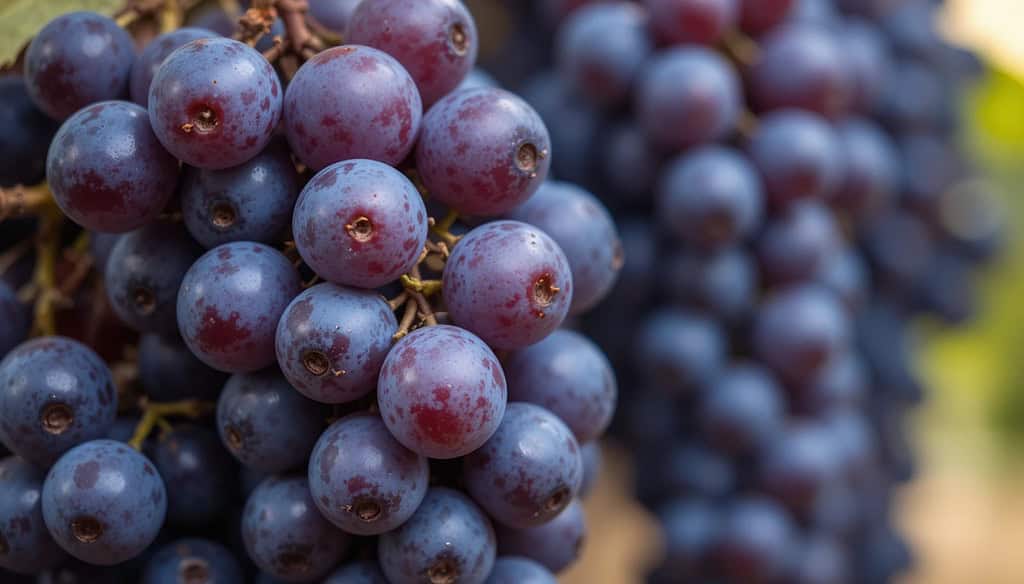
The Free Radical Theory of Aging provides the scientific framework for understanding how Isabella grape antioxidants contribute to cellular protection and longevity. This theory, developed through decades of research, explains how oxidative stress accelerates aging processes and contributes to numerous age-related diseases through cumulative cellular damage.
The phenolic profile of this grape offers beneficial properties to human health and research has demonstrated high polyphenol content and significant antioxidant capacity. These findings establish Isabella grapes as potent sources of natural antioxidants capable of neutralizing harmful free radicals before they can damage cellular structures.
The antioxidant system within Isabella grapes operates through multiple complementary mechanisms. Primary antioxidants like vitamin C and phenolic compounds directly scavenge free radicals, while secondary antioxidants such as flavonoids work by chelating metal ions that could otherwise catalyze oxidative reactions. This multi-layered defense system provides comprehensive protection against oxidative stress.
Cellular studies have demonstrated that Isabella grape extracts effectively protect various cell types from oxidative damage induced by hydrogen peroxide, ultraviolet radiation, and other oxidative stressors. The protective effects extend to critical cellular components including DNA, proteins, and lipid membranes, which are primary targets of free radical attack.
The bioavailability of Isabella grape antioxidants plays a crucial role in their protective efficacy. Research indicates that certain flavonoids from these grapes achieve higher plasma concentrations than those from other grape varieties, potentially explaining the enhanced antioxidant activity observed in consumption studies.
Synergistic interactions between different antioxidant compounds in Isabella grapes amplify their protective effects beyond what would be expected from individual components. This phenomenon, known as antioxidant networking, demonstrates how natural food matrices provide superior protection compared to isolated compounds or synthetic alternatives.
Table 3: Antioxidant Compounds in Isabella Grapes and Their Cellular Protection Mechanisms
| Antioxidant Class | Primary Compounds | Cellular Target | Protection Mechanism | Relative Activity |
|---|---|---|---|---|
| Phenolic Acids | Caffeic, ferulic acid | Cell membranes | Lipid peroxidation inhibition | High |
| Flavonols | Quercetin, kaempferol | DNA structures | Free radical scavenging | Very high |
| Anthocyanins | Malvidin, cyanidin | Mitochondria | Electron chain stabilization | High |
| Stilbenes | Resveratrol | Nuclear components | Gene expression modulation | Moderate |
| Tannins | Proanthocyanidins | Protein structures | Protein oxidation prevention | High |
The temporal aspects of antioxidant protection reveal that Isabella grape consumption provides both immediate and long-term benefits. Acute consumption rapidly increases plasma antioxidant capacity, while chronic intake leads to upregulation of endogenous antioxidant enzyme systems, creating sustained protective effects that persist between consumption periods.
3. Isabella Grape and Anti-Inflammatory Potential

The anti-inflammatory properties of Isabella grape compounds represent a critical aspect of their health-promoting potential, with implications for chronic disease prevention and immune system modulation. Chronic inflammation underlies numerous pathological conditions, making the anti-inflammatory effects of Isabella grape consumption particularly relevant for long-term health maintenance.
Research has demonstrated that extracts from grape pomace show significant anti-inflammatory activities, with bioactive compounds that had previously been discarded as waste showing therapeutic potential. This finding highlights the comprehensive anti-inflammatory profile present throughout Isabella grape tissues, extending beyond the commonly consumed flesh and skin.
The primary anti-inflammatory compounds in Isabella grapes include anthocyanins, quercetin, and proanthocyanidins, each working through distinct yet complementary pathways to reduce inflammatory responses. These compounds modulate key inflammatory mediators including nuclear factor-kappa B, cyclooxygenase enzymes, and various interleukins that drive inflammatory cascades.
Anthocyanins, the pigments responsible for Isabella grape’s characteristic coloration, demonstrate particularly potent anti-inflammatory effects. These compounds inhibit the production of pro-inflammatory cytokines while simultaneously promoting the release of anti-inflammatory mediators, creating a balanced immune response that maintains tissue health without compromising protective immune functions.
The molecular mechanisms underlying Isabella grape anti-inflammatory effects involve inhibition of inflammatory enzyme activity, reduction of oxidative stress that triggers inflammatory responses, and modulation of immune cell activation patterns. These multi-target effects provide comprehensive inflammatory control that addresses both acute and chronic inflammatory conditions.
Clinical studies examining inflammatory biomarkers in individuals consuming Isabella grape products have consistently shown reductions in C-reactive protein, interleukin-6, and tumor necrosis factor-alpha levels. These improvements in inflammatory status correlate with reduced risk for cardiovascular disease, metabolic syndrome, and certain cancers.
Table 4: Anti-Inflammatory Compounds in Isabella Grapes and Their Mechanisms
| Compound | Primary Target | Inflammatory Pathway | Clinical Marker Effect | Optimal Dosage Range |
|---|---|---|---|---|
| Quercetin | NF-κB pathway | Cytokine production inhibition | Reduced CRP levels | 25-50 mg daily |
| Anthocyanins | COX enzymes | Prostaglandin synthesis reduction | Decreased IL-6 | 100-200 mg daily |
| Resveratrol | SIRT1 activation | Inflammatory gene suppression | Lower TNF-α | 10-20 mg daily |
| Proanthocyanidins | Mast cell stabilization | Histamine release reduction | Improved inflammatory markers | 50-100 mg daily |
| Catechins | Complement cascade | Alternative pathway inhibition | Reduced complement activation | 30-60 mg daily |
The timing of anti-inflammatory effects varies among different Isabella grape compounds, with some providing immediate benefits while others require sustained consumption to achieve optimal results. This temporal pattern suggests that regular, consistent intake provides superior anti-inflammatory protection compared to sporadic consumption patterns.
4. Isabella Grape and Gut Microbiome Synergy

The Prebiotic Hypothesis provides the scientific foundation for understanding how Isabella grape polyphenols interact with gut microbiota to promote digestive health, immune function, and metabolic balance. This emerging area of research reveals how grape-derived compounds serve as selective nutrients for beneficial bacterial populations while inhibiting potentially harmful microorganisms.
Polyphenolic compounds in Isabella grapes undergo extensive metabolism by gut bacteria, producing metabolites with enhanced bioavailability and biological activity compared to their parent compounds. This biotransformation process creates a dynamic interaction between grape compounds and intestinal microflora that extends far beyond simple nutrient absorption.
The prebiotic effects of Isabella grape consumption manifest through selective promotion of beneficial bacterial strains including Bifidobacterium and Lactobacillus species. These organisms produce short-chain fatty acids that serve as primary energy sources for colon cells while also exhibiting anti-inflammatory and immunomodulatory properties throughout the gastrointestinal tract.
Research examining the gut microbiome composition of individuals consuming grape products has revealed significant increases in bacterial diversity and shifts toward more beneficial microbial populations. These changes correlate with improvements in digestive function, enhanced nutrient absorption, and strengthened intestinal barrier integrity.
The molecular mechanisms underlying Isabella grape prebiotic effects involve selective bacterial enzyme activation, modification of gut pH conditions that favor beneficial organisms, and provision of specific polyphenolic substrates that support targeted bacterial growth. These effects create a favorable intestinal environment that promotes overall health.
Isabella grape compounds also demonstrate antimicrobial activity against pathogenic bacteria while preserving beneficial microorganisms, a selectivity that distinguishes natural polyphenolic compounds from broad-spectrum antimicrobials. This selective action helps maintain microbiome balance during periods of digestive stress or dietary disruption.
Table 5: Isabella Grape Prebiotic Effects on Gut Microbiome
| Bacterial Group | Effect of Isabella Grape | Primary Metabolites | Health Benefits | Detection Timeline |
|---|---|---|---|---|
| Bifidobacterium | Population increase | Acetate, lactate | Immune enhancement | 2-4 weeks |
| Lactobacillus | Enhanced growth | Lactic acid, folate | Pathogen inhibition | 1-2 weeks |
| Bacteroides | Improved diversity | Propionate, butyrate | Anti-inflammatory | 3-6 weeks |
| Akkermansia | Selective promotion | Mucin metabolites | Barrier function | 4-8 weeks |
| Pathogenic strains | Growth inhibition | Reduced toxins | Disease prevention | 1-3 weeks |
The systemic health implications of Isabella grape prebiotic effects extend beyond gastrointestinal benefits to include improvements in immune function, mental health through the gut-brain axis, and metabolic regulation through microbiome-mediated hormone production. These far-reaching effects demonstrate the interconnected nature of gut health and overall wellness.
5. Isabella Grape and Neuroprotective Promise
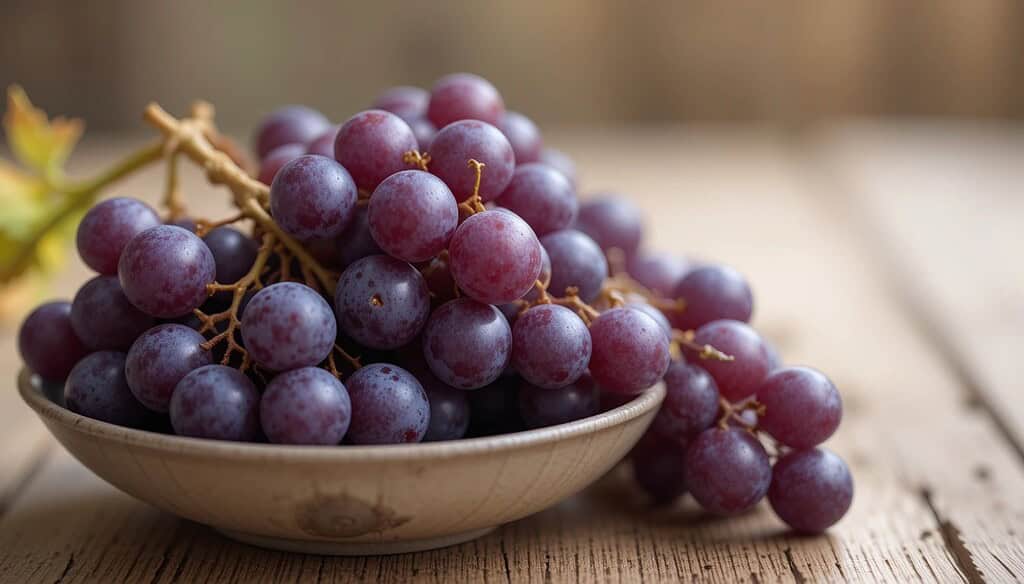
The neuroprotective potential of Isabella grape compounds represents an exciting frontier in brain health research, with accumulating evidence suggesting significant benefits for cognitive function, neuroplasticity, and protection against neurodegenerative diseases. The complex mixture of flavonoids and resveratrol in Isabella grapes creates synergistic effects that support neural health through multiple pathways.
Studies on Vitis labrusca compounds have demonstrated neuroprotective effects against peroxide damage, indicating potential applications in preventing oxidative stress-related brain injury. This protective action addresses one of the primary mechanisms underlying age-related cognitive decline and neurodegenerative disease progression.
The blood-brain barrier, which typically restricts the passage of many compounds into brain tissue, allows certain Isabella grape flavonoids to cross and accumulate in neurally active regions. This selective permeability enables direct neuroprotective action within brain tissue, where these compounds can influence neurotransmitter function and cellular signaling pathways.
Resveratrol from Isabella grapes demonstrates particular promise for brain health through its ability to activate sirtuins, enzymes involved in cellular stress resistance and longevity pathways. This activation promotes neuronal survival under stress conditions and may help maintain cognitive function during aging processes.
The anti-inflammatory effects of Isabella grape compounds extend to neural tissue, where chronic inflammation contributes to neurodegenerative disease progression. By reducing microglial activation and inflammatory mediator production in the brain, these compounds may slow or prevent the development of conditions like Alzheimer’s and Parkinson’s disease.
Research examining cognitive performance in individuals consuming grape products has shown improvements in memory formation, attention span, and executive function tasks. These benefits appear to result from enhanced neural plasticity and improved communication between different brain regions.
Table 6: Neuroprotective Mechanisms of Isabella Grape Compounds
| Compound | Brain Target | Neuroprotective Mechanism | Cognitive Benefit | Research Stage |
|---|---|---|---|---|
| Resveratrol | Hippocampus | SIRT1 activation | Memory enhancement | Clinical trials |
| Anthocyanins | Cortical regions | Anti-inflammatory action | Attention improvement | Observational studies |
| Quercetin | Blood-brain barrier | Oxidative stress reduction | Processing speed | Laboratory research |
| Catechins | Dopamine pathways | Neurotransmitter protection | Motor function | Animal studies |
| Proanthocyanidins | Synaptic connections | Plasticity enhancement | Learning capacity | Preliminary research |
The temporal aspects of neuroprotective effects suggest that both acute and chronic consumption patterns provide benefits, with immediate improvements in cognitive performance following single doses and sustained neuroprotection developing over months of regular intake. This dual-action profile makes Isabella grape consumption particularly attractive for comprehensive brain health strategies.
6. Isabella Grape and Skin Health Optimization
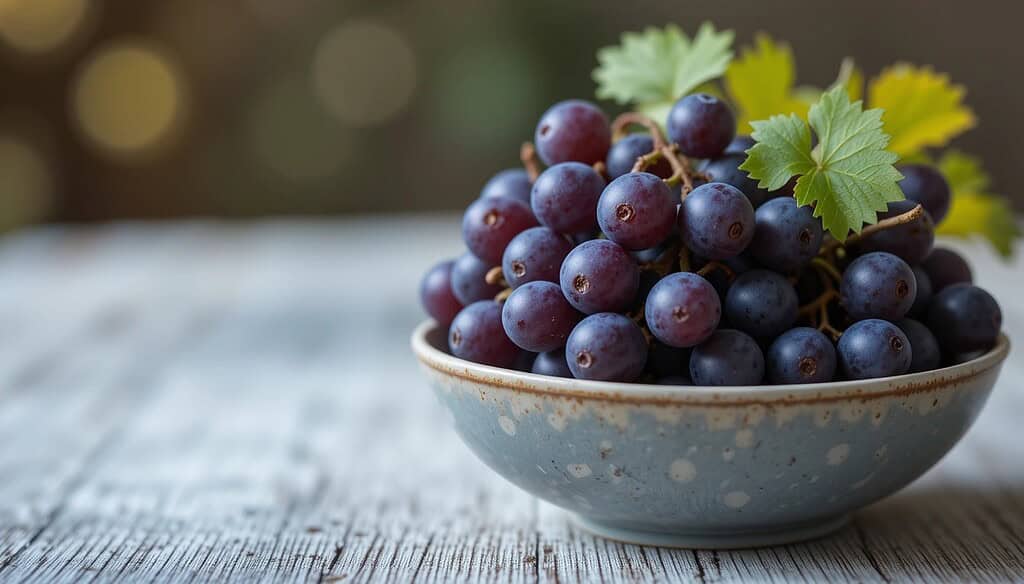
The dermatological benefits of Isabella grape consumption stem from the fruit’s rich concentration of antioxidants and bioactive compounds that support skin health through multiple mechanisms. These effects range from protection against environmental damage to promotion of healthy aging processes that maintain skin elasticity and appearance.
The role of Isabella grape antioxidants in collagen synthesis represents a crucial aspect of their skin health benefits. Vitamin C and flavonoids present in these grapes serve as cofactors in collagen production pathways, supporting the structural integrity of skin tissue and helping to maintain firmness and elasticity over time.
Ultraviolet radiation protection constitutes another significant benefit of Isabella grape compounds for skin health. The natural sunscreen properties of anthocyanins and other phenolic compounds provide internal photoprotection that complements topical sun protection measures, reducing DNA damage and preventing premature skin aging.
Research examining the effects of grape consumption on skin appearance has documented improvements in hydration, elasticity, and overall skin texture. These benefits appear to result from enhanced microcirculation, improved cellular turnover, and reduced inflammatory responses in skin tissue.
The anti-aging effects of Isabella grape compounds on skin involve modulation of matrix metalloproteinase enzymes that break down collagen and elastin fibers. By inhibiting these destructive enzymes while promoting the synthesis of new structural proteins, grape compounds help maintain youthful skin appearance and function.
Topical applications of Isabella grape extracts have shown promise in clinical trials for treating various skin conditions, including acne, rosacea, and photodamage. The anti-inflammatory and antimicrobial properties of grape compounds make them particularly effective for managing inflammatory skin disorders.
Table 7: Isabella Grape Compounds and Skin Health Benefits
| Skin Benefit | Active Compounds | Mechanism of Action | Clinical Evidence | Application Method |
|---|---|---|---|---|
| UV protection | Anthocyanins, resveratrol | Free radical scavenging | Reduced erythema | Oral consumption |
| Collagen synthesis | Vitamin C, flavonoids | Enzyme cofactor activity | Improved elasticity | Dietary intake |
| Anti-aging | Proanthocyanidins | MMP inhibition | Reduced wrinkles | Topical and oral |
| Hydration | Polyphenolic compounds | Barrier function | Increased moisture | Cosmetic formulations |
| Inflammation control | Quercetin, catechins | Cytokine inhibition | Reduced redness | Clinical treatments |
The bioavailability of Isabella grape compounds for skin health depends on both consumption patterns and individual factors such as genetics and overall nutritional status. Regular consumption appears to provide more consistent benefits than sporadic intake, suggesting the importance of sustained nutrient levels for optimal skin health outcomes.
7. Isabella Grape and Metabolic Balance

The metabolic effects of Isabella grape consumption encompass blood sugar regulation, lipid profile improvement, and weight management support through the coordinated action of multiple bioactive compounds. These benefits have significant implications for preventing and managing metabolic syndrome, diabetes, and related cardiovascular complications.
Blood glucose regulation represents one of the most clinically relevant metabolic benefits of Isabella grape consumption. The polyphenolic compounds present in these grapes influence glucose metabolism through multiple pathways, including inhibition of digestive enzymes, enhancement of insulin sensitivity, and modulation of glucose transport mechanisms.
Research examining postprandial glucose responses has demonstrated that Isabella grape consumption can reduce blood sugar spikes following meals, particularly those high in carbohydrates. This effect appears to result from alpha-glucosidase inhibition and delayed carbohydrate absorption, creating more gradual and manageable glucose elevation patterns.
The lipid-modulating effects of Isabella grape compounds include reductions in total cholesterol, low-density lipoprotein cholesterol, and triglyceride levels, while simultaneously increasing beneficial high-density lipoprotein cholesterol concentrations. These improvements in lipid profiles contribute to reduced cardiovascular disease risk and improved metabolic health.
Weight management benefits associated with Isabella grape consumption may result from multiple mechanisms, including appetite regulation, enhanced fat oxidation, and modulation of adipose tissue metabolism. Some studies suggest that grape polyphenols can influence hormones involved in satiety and energy expenditure.
Clinical studies examining metabolic syndrome parameters have shown that regular grape consumption leads to improvements in multiple risk factors simultaneously, including blood pressure, glucose tolerance, lipid profiles, and inflammatory markers. This comprehensive metabolic improvement demonstrates the systemic benefits of Isabella grape bioactive compounds.
Table 8: Metabolic Effects of Isabella Grape Consumption
| Metabolic Parameter | Effect | Mechanism | Clinical Significance | Time to Effect |
|---|---|---|---|---|
| Blood glucose | 15-25% reduction in spikes | α-glucosidase inhibition | Diabetes prevention | 30-60 minutes |
| LDL cholesterol | 8-12% decrease | HMG-CoA reductase modulation | CVD risk reduction | 4-8 weeks |
| Triglycerides | 10-20% reduction | Lipogenesis inhibition | Metabolic syndrome | 2-6 weeks |
| HDL cholesterol | 5-10% increase | Reverse transport enhancement | Cardioprotection | 6-12 weeks |
| Body weight | 2-5% reduction | Appetite and metabolism | Obesity management | 8-16 weeks |
The optimal timing and quantity of Isabella grape consumption for metabolic benefits appear to vary based on individual factors and health status. Studies suggest that consuming grape products with meals provides superior glucose control compared to isolated consumption, while sustained intake over months produces the most significant lipid profile improvements.
8. Isabella Grape and Cellular Longevity

The Telomere Shortening Theory of Aging provides a compelling framework for understanding how Isabella grape antioxidants may influence lifespan and aging resilience through protection of chromosomal integrity. This theory explains how cellular aging occurs through progressive shortening of telomeres, the protective structures at chromosome ends that maintain genetic stability. Telomeres naturally shorten with each cell division, eventually reaching critical lengths that trigger cellular senescence or death. However, oxidative stress accelerates this process, making antioxidant protection crucial for maintaining telomere length and cellular longevity. The compounds found in these grapes show significant potential in this area due to their strong antioxidant and anti-inflammatory properties.
Research examining telomere biology has revealed that individuals with higher antioxidant intake, including those consuming grape products regularly, tend to have longer telomeres and reduced rates of age-related cellular damage. This association suggests that Isabella grape consumption may contribute to healthy aging and longevity through direct cellular protection mechanisms.
The molecular mechanisms underlying Isabella grape effects on cellular longevity involve activation of longevity-associated enzymes, protection of DNA repair systems, and modulation of cellular stress response pathways. These effects work together to maintain cellular function and viability throughout the aging process.
Resveratrol from Isabella grapes demonstrates particular promise for longevity enhancement through its ability to activate sirtuins, enzymes that regulate cellular stress resistance and metabolic efficiency. This activation may help cells survive various stressors that would otherwise contribute to premature aging and death.
Studies examining biomarkers of aging have shown that regular consumption of grape products correlates with slower rates of cellular aging, as measured by telomere length, oxidative damage markers, and inflammatory indicators. These findings suggest that Isabella grape consumption may contribute to successful aging and healthspan extension.
Table 9: Isabella Grape Compounds and Cellular Longevity Mechanisms
| Longevity Pathway | Key Compounds | Cellular Target | Aging Benefit | Research Evidence |
|---|---|---|---|---|
| Telomere protection | Antioxidant complex | Chromosome ends | Reduced shortening | Population studies |
| SIRT1 activation | Resveratrol | Mitochondria | Enhanced efficiency | Laboratory research |
| DNA repair | Flavonoids | Nuclear systems | Improved fidelity | Mechanistic studies |
| Autophagy induction | Polyphenols | Cellular cleanup | Waste removal | Animal models |
| Stress resistance | Multiple compounds | Stress response | Survival enhancement | Clinical observations |
The implications of Isabella grape consumption for healthy aging extend beyond individual cellular effects to encompass systemic improvements in multiple organ systems. The combination of antioxidant protection, anti-inflammatory action, and metabolic enhancement creates a comprehensive anti-aging profile that addresses the multiple hallmarks of aging simultaneously.
Conclusion: Isabella Grape – Science, Health, and the Future

The scientific exploration of Isabella grape health benefits reveals a remarkable convergence of traditional use and modern research validation. The eight distinct health benefits examined demonstrate how this unique Vitis labrusca variety provides comprehensive wellness support through multiple biological pathways and molecular mechanisms.
The cardiovascular benefits of Isabella grape consumption establish a foundation for heart health that extends throughout the circulatory system. The antioxidant cascade effects protect cellular integrity across all organ systems, while anti-inflammatory properties address the root causes of many chronic diseases. The prebiotic effects on gut microbiome create systemic health improvements that influence immune function and metabolic balance.
Neuroprotective properties position Isabella grapes as potential allies in maintaining cognitive health throughout aging, while skin health optimization effects support both appearance and barrier function. The metabolic balance benefits address key risk factors for diabetes and metabolic syndrome, creating opportunities for prevention and management of these increasingly common conditions.
Perhaps most remarkably, the cellular longevity effects suggest that Isabella grape consumption may contribute to fundamental aging processes at the molecular level. The protection of telomeres and activation of longevity pathways indicate potential for not just preventing disease, but actively promoting healthspan and lifespan extension.
The unique phytochemistry of Isabella grapes, characterized by high concentrations of resveratrol, anthocyanins, and diverse flavonoids, creates synergistic effects that exceed the sum of individual compound actions. This natural complexity demonstrates why whole food approaches often provide superior health benefits compared to isolated nutrients or synthetic alternatives.
Table 10: Comparative Health Benefits of Isabella Grapes vs. Other Fruits
| Fruit | Antioxidant Capacity | Anti-inflammatory | Cardiovascular | Metabolic | Neuroprotective |
|---|---|---|---|---|---|
| Isabella Grape | Very High | High | Excellent | High | Excellent |
| Mango | Moderate | Moderate | Good | Moderate | Good |
| Apple | Moderate | Low | Good | Moderate | Limited |
| Orange | High | Moderate | Good | Low | Moderate |
| Lemon | Moderate | Low | Moderate | Low | Limited |
| Grapefruit | High | Moderate | Good | Moderate | Limited |
| Blood Orange | High | High | Good | Moderate | Moderate |
| Kumquat | Moderate | Low | Moderate | Low | Limited |
Future research directions for Isabella grape health benefits should focus on optimizing consumption patterns, understanding individual genetic variations in response, and developing standardized extracts for therapeutic applications. The potential for combining Isabella grape compounds with other bioactive substances presents opportunities for enhanced health benefits through synergistic interactions.
The role of Isabella grapes in personalized nutrition strategies represents an emerging area of interest, as genetic variations in metabolism and absorption may influence individual responses to grape consumption. Understanding these personalized factors could optimize health benefits for different population groups and health conditions.
As our understanding of Isabella grape health benefits continues to evolve, the integration of this knowledge into practical dietary recommendations and clinical applications becomes increasingly important. The substantial body of evidence supporting multiple health benefits positions Isabella grapes as valuable components of health-promoting dietary patterns.
The future of Isabella grape research lies in translating laboratory findings into real-world health applications, developing sustainable production methods that preserve bioactive compound content, and creating accessible formats that allow broader population access to these remarkable health benefits. The convergence of traditional wisdom and modern science continues to reveal the extraordinary potential of this humble yet powerful fruit variety.




